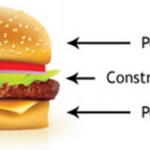 Feedback is crucial to improvement, whether it’s as an individual or as an organisation. Despite it’s importance however, the act of delivering it is something that few of us are all that good at doing. This is especially so when the feedback is negative in some way.
Feedback is crucial to improvement, whether it’s as an individual or as an organisation. Despite it’s importance however, the act of delivering it is something that few of us are all that good at doing. This is especially so when the feedback is negative in some way.
I mean what if they react badly? What if they dislike you as a result of your critique? All of these things go through our mind, and these fears often prevent us from saying or doing anything, which is of course no use to anyone.
One of the more frequently touted strategies to overcome this situation is known as the praise sandwich. It involves you warming up your target with some praise, then delivering your critique, before finishing things off with another bit of praise.
The easy analogy makes this quite an enduring and popular tactic, even though research suggests it really isn’t very effective.
The study, published in the Personality and Social Psychology Bulletin suggests that using the praise sandwhich may be an inherently selfish strategy.
“Our findings suggest that the primary beneficiary of the bad news sandwich is news-givers, not news-recipients.
Although recipients may be pleased to end on a high note, they are unlikely to enjoy anxiously waiting for the other shoe to drop during the initial good news.”
Getting bad news out of the way
Indeed, the study suggests that most people would actually prefer it if they received their bad news straight away, without any attempts to soften the blow. It is generally those giving the feedback that prefer the sandwich based approach.
The study goes on to suggest that this is a particular problem for those professions whereby giving bad news is particularly important. Professions such as medicine and education need to be able to give bad news to patients and students.
It goes on to reveal that a major part of the issue is that we forget how we’d like to receive the feedback ourselves, and instead give it from our own perspectives.
“Our findings suggest that the doctors, teachers and partners in these examples might do a poor job of giving good and bad news because they forget for a moment how they want to hear the news when they are the patients, students, and spouses, respectively.
News-givers attempt to delay the unpleasant experience of giving bad news by leading with good news while recipients grow anxious knowing that the bad news is yet to come.”
An unwholesome sandwich
So the praise sandwhich can be totally counter-productive, because it overlooks the whole point of delivering feedback in the first place – getting that person to change their ways.
The sandwich style approach can often lead the recipient confused about the message being communicated, thus rendering the whole painful exercise a waste of time.
So what’s a better way?
The key is to try and create a culture whereby feedback is normal and expected. That way there isn’t such a drama involved in its delivery, and recipients will regard it as a positive step towards them getting better.
Four things can help you on your way to obtaining that kind of culture:
- Give people confidence that feedback, both good and bad, are both welcome and appreciated. People shouldn’t be afraid that it might dent their promotional prospects for instance.
- Try and make the giving of feedback a regular and routine occurence. Too often companies reserve it for annual set piece events such as 360 degree feedback appraisals. This is bad.
- Make sure you give praise and thanks as well as you do criticism. We all like to hear that we’ve done a good job, so don’t be shy.
- Leaders should take the lead. It’s especially hard to critique those higher up than you, so leaders need to make a conscious effort to walk the walk when it comes to wanting feedback.
If you can do these things then hopefully it will help you to consign the praise sandwich to the bin, where it belongs.
Has the praise sandwich ever been valued? I've always thought it was kind of a joke really.